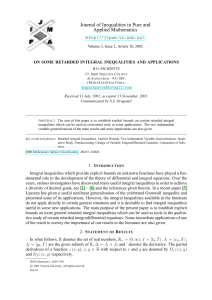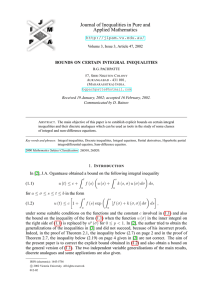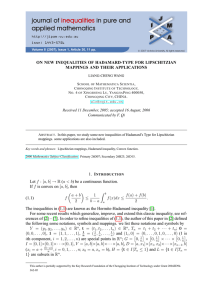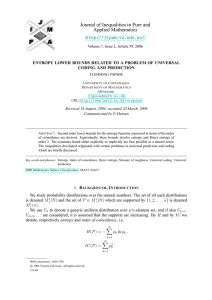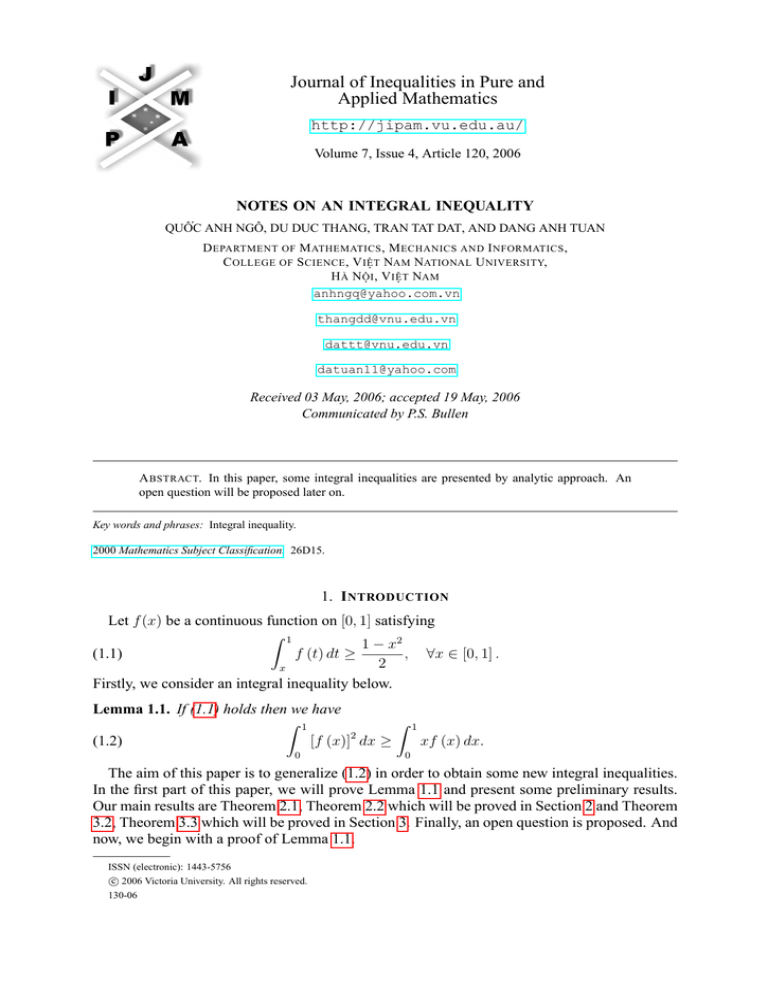
Journal of Inequalities in Pure and
Applied Mathematics
http://jipam.vu.edu.au/
Volume 7, Issue 4, Article 120, 2006
NOTES ON AN INTEGRAL INEQUALITY
QUÔ´C ANH NGÔ, DU DUC THANG, TRAN TAT DAT, AND DANG ANH TUAN
D EPARTMENT OF M ATHEMATICS , M ECHANICS AND I NFORMATICS ,
C OLLEGE OF S CIENCE , V IÊ. T NAM NATIONAL U NIVERSITY,
H À N Ô. I , V IÊ. T NAM
anhngq@yahoo.com.vn
thangdd@vnu.edu.vn
dattt@vnu.edu.vn
datuan11@yahoo.com
Received 03 May, 2006; accepted 19 May, 2006
Communicated by P.S. Bullen
A BSTRACT. In this paper, some integral inequalities are presented by analytic approach. An
open question will be proposed later on.
Key words and phrases: Integral inequality.
2000 Mathematics Subject Classification. 26D15.
1. I NTRODUCTION
Let f (x) be a continuous function on [0, 1] satisfying
Z 1
1 − x2
(1.1)
f (t) dt ≥
, ∀x ∈ [0, 1] .
2
x
Firstly, we consider an integral inequality below.
Lemma 1.1. If (1.1) holds then we have
Z 1
Z
2
(1.2)
[f (x)] dx ≥
0
1
xf (x) dx.
0
The aim of this paper is to generalize (1.2) in order to obtain some new integral inequalities.
In the first part of this paper, we will prove Lemma 1.1 and present some preliminary results.
Our main results are Theorem 2.1, Theorem 2.2 which will be proved in Section 2 and Theorem
3.2, Theorem 3.3 which will be proved in Section 3. Finally, an open question is proposed. And
now, we begin with a proof of Lemma 1.1.
ISSN (electronic): 1443-5756
c 2006 Victoria University. All rights reserved.
130-06
2
Q.A. N GÔ , D.D. T HANG , T.T. DAT ,
Proof of Lemma 1.1. It is known that
Z 1
Z
2
0≤
(f (x) − x) dx =
0
D.A. T UAN
AND
1
1
Z
2
f (x) dx − 2
Z
xf (x) dx +
0
0
1
x2 dx,
0
which yields
Z
1
1
Z
2
f (x) dx ≥ 2
Let A :=
R 1 R 1
0
x
1
xf (x) dx − .
3
0
0
f (t) dt . By using our assumption we have
Z 1
Z 1 Z 1
1 − x2
1
A=
f (t) dt ≥
dx = .
2
3
0
x
0
On the other hand, integrating by parts, we also get
Z 1 Z 1
A=
f (t) dt
0
x
1
Z
=x
x
Z
1 Z
f (t) dt +
1
xf (x) dx
0
0
1
=
xf (x) dx.
0
Thus
Z
0
1
1
xf (x) dx ≥ ,
3
which gives the conclusion.
Remark 1.2. Condition (1.1) can be rewritten as
Z 1
Z 1
(1.3)
f (t) dt ≥
tdt,
x
∀x ∈ [0, 1] .
x
Throughout this paper, we always assume that function f satisfies (1.1), moreover, we also
assume that
f (x) ≥ 0
(1.4)
for every x ∈ [0, 1].
R1
Lemma 1.3. 0 xn+1 f (x) dx ≥
1
n+3
for all n ∈ N.
Proof. We have
Z
1
x
n
Z
0
1
f (t) dt dx =
x
1
Z
1
n+1
1
Z
0
f (t) dt d xn+1
x
1
=
xn+1
n+1
Z
1
x
x=1
f (t) dt
x=0
1
+
n+1
Z
1
1
1
xn+1 f (x) dx,
0
which yields
Z
1
x
n+1
Z
f (x) dx = (n + 1)
0
J. Inequal. Pure and Appl. Math., 7(4) Art. 120, 2006
x
0
n
Z
f (t) dt dx.
x
http://jipam.vu.edu.au/
N OTES ON AN I NTEGRAL I NEQUALITY
On the other hand
1
Z
x
n
Z
0
Therefore
1
Z
f (t) dt dx ≥
x
x
n+1
xn
0
1
Z
1
1
Z
f (x) dx ≥ (n + 1)
0
x
n1
0
3
1 − x2
dx.
2
− x2
1
dx =
.
2
n+3
The proof is completed.
2. T HE C ASE
OF
N ATURAL N UMBERS
Theorem 2.1. Assume that (1.1) and (1.4) hold. Then
Z 1
Z 1
n+1
f
(x) dx ≥
xn f (x) dx
0
0
for every n ∈ N.
Proof. By using the Cauchy inequality, we obtain
f n+1 (x) + nxn+1 ≥ (n + 1) xn f (x) .
Thus
Z
1
f
n+1
1
Z
(x) dx + n
0
x
n+1
0
0
1
f
n+1
0
1
Z
n
1
x f (x) dx +
xn f (x) dx
0
Z 1
n
+
xn f (x) dx,
≥
n+2
0
0
Z
xn f (x) dx.
dx ≥ (n + 1)
Moreover, by using Lemma 1.3, we get
Z 1
Z
n
(n + 1)
x f (x) dx = n
that is
1
Z
0
n
n
(x) dx +
≥
+
n+2
n+2
Z
1
xn f (x) dx,
0
which completes this proof.
Theorem 2.2. Assume that (1.1) and (1.4) hold. Then
Z 1
Z 1
n+1
f
(x) dx ≥
xf n (x) dx
0
0
for every n ∈ N.
Proof. It is known that
(f n (x) − xn ) (f (x) − x) ≥ 0,
∀x ∈ [0, 1] ,
that is
f n+1 (x) + xn+1 ≥ xn f (x) + xf n (x) , ∀x ∈ [0, 1] .
By integrating with some simple calculation we conclude that
Z 1
Z 1
Z 1
1
n+1
n
f
(x) dx +
≥
x f (x) dx +
xf n (x) dx.
n+2
0
0
0
Once again, by Lemma 1.3, we obtain
Z 1
Z 1
1
1
n+1
f
(x) dx +
≥
+
xf n (x) dx,
n+2
n+2
0
0
which gives the conclusion.
J. Inequal. Pure and Appl. Math., 7(4) Art. 120, 2006
http://jipam.vu.edu.au/
4
Q.A. N GÔ , D.D. T HANG , T.T. DAT ,
AND
D.A. T UAN
Remark 2.3. By the same argument, we see that the result of Lemma 1.3 also holds when n is
a positive real number. That is
Z 1
1
(2.1)
xα+1 f (x) dx ≥
, ∀α > 0.
α+3
0
3. T HE C ASE
OF
R EAL N UMBERS
In order to generalize our results, the case of positive real numbers, we recall another version
of the Cauchy inequality as follows.
Theorem 3.1 (General Cauchy inequality). Let α and β be positive real numbers satisfying
α + β = 1. Then for every positive real numbers x and y, we always have
αx + βy ≥ xa y β .
Theorem 3.2. Assume that (1.1) and (1.4) hold. Then
Z 1
Z 1
α+1
f
(x) dx ≥
xα f (x) dx
0
0
for every positive real number α > 0.
Proof. Using Theorem 3.1 we get
1
α
f α+1 (x) +
xα+1 ≥ xα f (x) ,
α+1
α+1
which gives
Z 1
Z 1
Z 1
1
α
α+1
α+1
f
(x) dx +
x dx ≥
xα f (x) dx.
α+1 0
α+1 0
0
By the same argument together with (2.1) we obtain
Z 1
α
1
f α+1 (x) dx +
α+1 0
(α + 1) (α + 2)
Z 1
Z 1
1
α
α
≥
x f (x) dx +
xα f (x) dx
α+1 0
α+1 0
Z 1
1
α
≥
xα f (x) dx +
.
α+1 0
(α + 1) (α + 2)
Hence
Z 1
Z 1
1
1
α+1
f
(x) dx ≥
xα f (x) dx.
α+1 0
α+1 0
The present proof is completed.
Theorem 3.3. Assume that (1.1) and (1.4) hold. Then
Z 1
Z 1
α+1
f
(x) dx ≥
xf α (x) dx
0
0
for every positive real number α > 0.
The proof of Theorem 3.3 is similar to the proof of Theorem 2.2 therefore, we omit it.
Lastly, we propose the following open problem.
Open Problem. Let f (x) be a continuous function on [0, 1] satisfying
Z 1
Z 1
f (t) dt ≥
tdt, ∀x ∈ [0, 1] .
x
J. Inequal. Pure and Appl. Math., 7(4) Art. 120, 2006
x
http://jipam.vu.edu.au/
N OTES ON AN I NTEGRAL I NEQUALITY
Under what conditions does the inequality
Z 1
Z
α+β
f
(x) dx ≥
0
5
1
tα f β (x) dx.
0
hold for α and β?
R EFERENCES
[1] E.F. BECKENBACH AND R. BELLMAN, Inequalities, Springer, Berlin, 1983.
[2] G.H. HARDY, J.E. LITTLEWOOD
sity Press, Cambridge, 1952.
AND
G. PÓLYA, Inequalities, 2nd edition, Cambridge Univer-
[3] JI-CHANG KUANG, Applied Inequalities, 2nd edition, Hunan Education Press, Changsha, China,
1993.
[4] D.S. MITRINOVIĆ, Analytic Inequalities, Springer-Verlag, Berlin, 1970.
[5] D.S. MITRINOVIĆ, J.E. PEČARIĆ AND A.M. FINK, Classical and New Inequalities in Analysis,
Kluwer Academic Publishers, Dordrecht, 1993.
J. Inequal. Pure and Appl. Math., 7(4) Art. 120, 2006
http://jipam.vu.edu.au/







